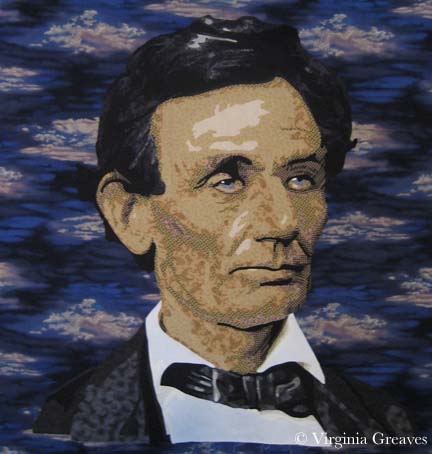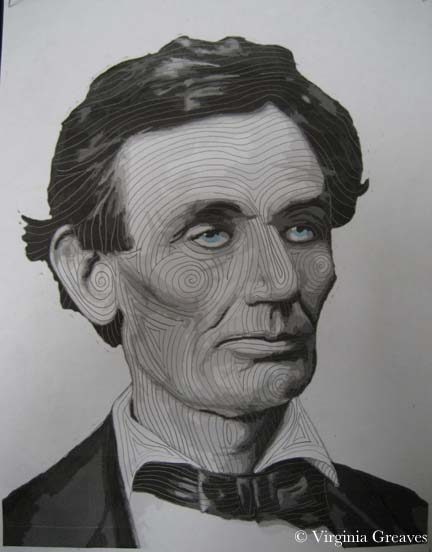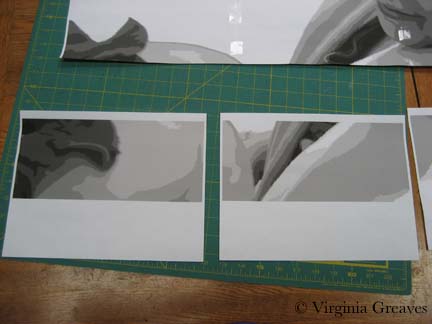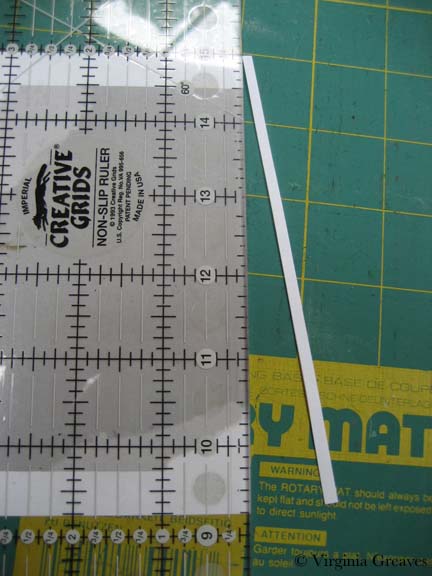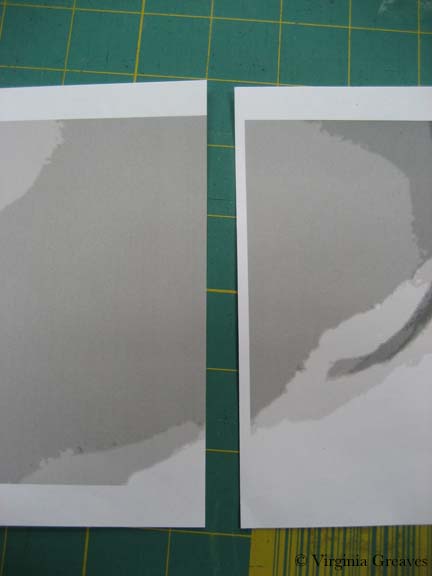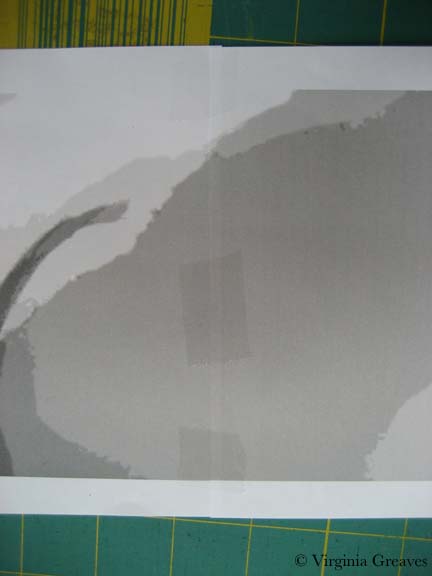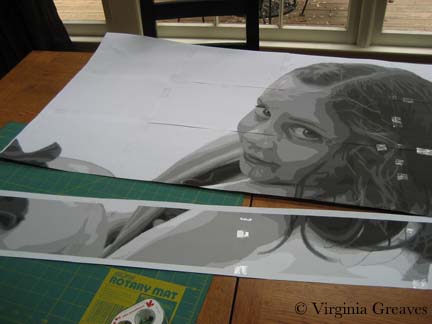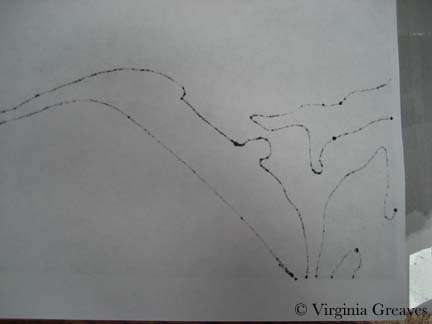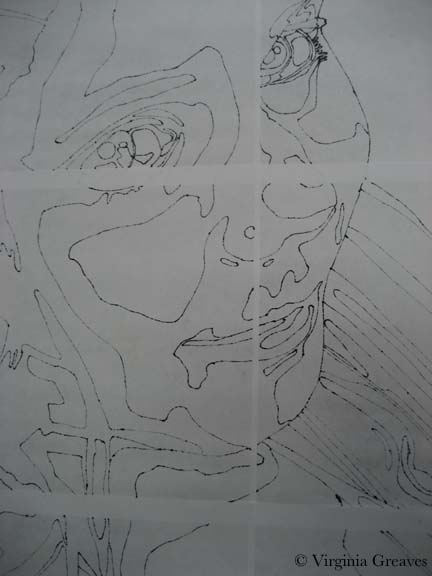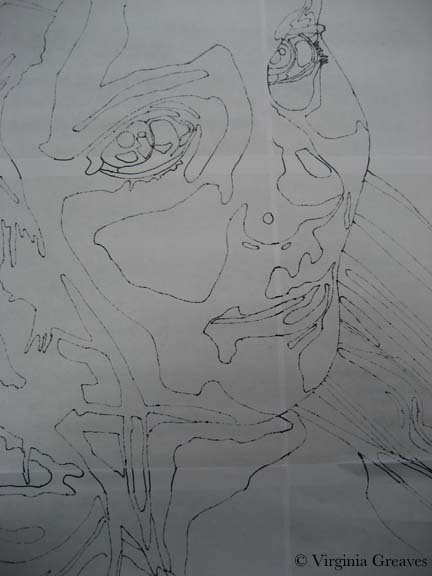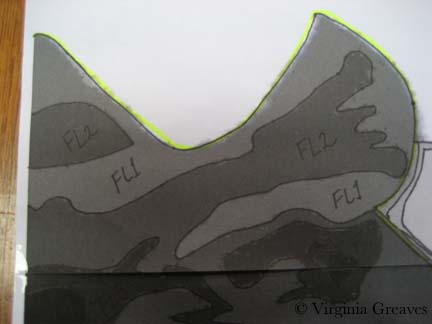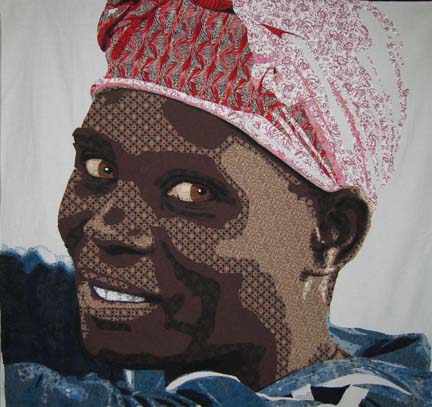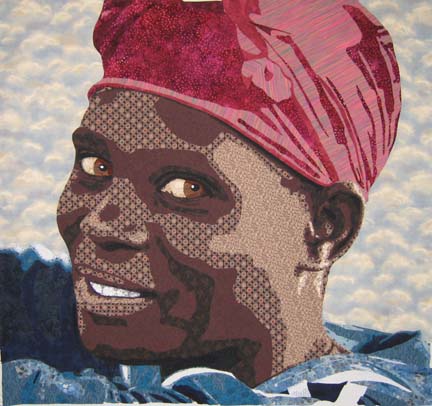Drawing

Me and Abe
3I am guilty of ignoring my blog. I took many pictures as I made his shirt, tie, coat, and finally his hair — but the progressions are not that interesting. The white doesn’t photograph well and the black — well I was overcome with black. Lincoln has a dour personage and although I didn’t intend this to be a dark piece, by nature of his hair and his clothing, there are a LOT of black prints in this piece.
This is how he looks on my black design wall. Not bad — but I thought he would look really good on a deep navy — something that would be lighter than his hair but still strong enough to evoke images of the Union flag. I even considered adding flag details in the background but decided that it would only distract from his piercing stare.
Clearly, I was wrong. It is hard to tell in the artificial lighting of most fabric stores how a value is really going to work. This one is much too dark. Sadly, I had been to a couple of local quilt stores, and this is the only one I felt had promise.
I found this sky fabric in my stash. It has a cool feel about it, almost as if Lincoln is standing on the battleground — but the white in the clouds is too distracting — another reason I finally declared that he needed a plainer background.
And then I found this green batik. It has a feeling of age to it. It has some texture in the print, but not much. It is exactly the right value. I wouldn’t have thought this would work — but there is some smoky blue in it that pulls out the color in his eyes — a faded gray that hopefully reflects weariness.
Today I’m pondering how to quilt him. I’ve been drawing on my picture of him. The lines of his face are so distinctive and different from what I’ve done before that I had to pull some new tricks out of my bag. The line under the left cheek for example had to be highlighted. The chin also sits in an awkward fashion and makes the joining of the cheek to the chin different from how I’ve approached it before.

Drafting, Drawing, Sketching, & Photoshop
1I am always asked about how I draft a pattern. Yes — I start with a digital picture. Yes — I use the posterize tool in Photoshop. And yet — if it were that easy — everyone would be doing it. Beyond the mechanics of the process — it’s a skill. The truth of the matter, as any good photographer will tell you, is that cameras lie. The more pictures you take, you’ll begin to see why. They don’t have the ability to record things in the same way as the human eye.
So my starting point is the photograph — but making the pattern believable requires some drawing. The eyes and the mouth are always wrong. The chin is rarely defined. The dimples that create character in some people’s faces are easily obscured in the light. And Photoshop isn’t perfect either. I use the information I receive from posterizing to start a value painting, but when you posterize, you often lose details that you want to keep and you have to add those back in. This usually takes me 3-4 days.
I have a Wacom tablet — not a big one — it’s the 2nd smallest — and I pick up colors and use the electronic pen to draw in Photoshop. I have the original picture in another layer that I can use for reference.
This is my latest piece, a small girl holding up a flower on the back of her hand and looking up expectantly. The important shape here are her eyes — and I’ve exaggerated some of the detail in them for that reason.
The value painting isn’t really my pattern — but it has everything I need. I used to take my value painting, export it as a BMP, pull it into CorelDraw, and then create my drawing in CorelDraw by drawing lines around all of my closed shapes. Then I would tile print it. It looks very professional when it’s done — but it does take longer than my Sharpie method.
I still export the file from Photoshop to a BMP file — and then I pull it into PosteRazor (which is shareware). I make it the size I want it, and then tile print it. (Tile printing, by the way, is sorely lacking in Photoshop.) At that point, I have to start putting the puzzle together.
This shows 2 sheets of the bottom left that need to be joined.
First I take off the right hand side of the first sheet (starting from the left) — and using a rotary cutter and a ruler, I take off the white strip that is not part of the pattern. (I also crop the bottom a little. If this wasn’t the bottom row, I would take off the white strip of the bottom as well.) I always take off two sides — the right and the bottom — so the pieces will fit together with overlap.
Now I can take the first piece and lay it directly onto the second piece.
Once I tape it, it’s seamless. Use clear tape and keep the tape within one value if at all possible. If you cross over values, your Sharpie won’t touch the paper and the ink won’t be visible on the other side of the paper.
The trick comes in putting it all together. I used to not be very good at it and my pattern would ripple with my mistakes. Don’t worry if it does. Retape it. You probably won’t lose much of a shape. But if you cut out the overlap carefully and tape it together carefully, you’ll have a flat pattern when you’re done.
You don’t want seams to fall in complex areas like the eyes. One reason I printed this out in landscape rather than portrait was to avoid that.
Once that’s done, outline your shapes using an ultra thin Sharpie.
This has the added benefit of creating the reverse of the pattern on the back — so from one tile printed & taped pattern — I get a front (used for the vinyl overlay) and a back (used for the Wonder Under patterns).
You can see here that this works great — except for the joins where the paper comes together.
Just grab a lightbox & draw in the missing lines. If you can’t see it, you can flip the paper back.
And finally, go back and label everything with value numbers. I always number the face F1, F2, etc. and then think up other prefixes for other things. In this drawing, FL stands for flower. And then grab a highlighter and mark the lines between areas — like the face, her shirt, her hand, the flower.
And since this is a value painting, you’ll find that your value shapes won’t always stop between objects. You have to go back in and add those lines yourself. I use a pencil until I get the lines where I like them — then go back over them with a Sharpie.
And — then you’re almost done — you flip the pattern back to the value side and tape vinyl over it and trace it out. Then you’ll sew the vinyl onto white fabric (using a Teflon foot that won’t stick to the vinyl). The fabric acts as your canvas, and the vinyl overlay is your road map showing you where to fuse your shapes.
Then flip the pattern back over to the back side — where there is no value distinction other than the letters & numbers you assigned to shapes — and you’ll use this to start tracing Wonder Under shapes.
That’s a lot of work before you even begin to look at fabric — but it’s time well spent. Keep in mind that whatever you draw, you have to be willing to cut it out and sew around it. Sometimes, you can use patterned fabric that will do some of the work for you. Often I draft tiny pieces that don’t end up in the final piece. And I’m always ready with a pencil to draw out changes at the last minute if something isn’t working out. Just because it’s been inked doesn’t mean it’s written in stone. If it’s wrong, change it. Sometimes you won’t see it until you start doing it. In this particular piece, one of her eyes was clearly wrong — and I sketched out my changes with a pencil and kept moving forward.

Muscular Industry
1With the children back in school, I spent all of last week finishing the appliqué on the 2nd figure and preparing the quilt sandwich.
After that, I always stumble. The blank canvas is daunting, and quilting is difficult to undo.
One of the criticisms of Just Call Me Jack that I received from a judge’s sheet from IQA Festival was that they found the quilted circles in his face distracting.
Knowing how to quilt the face is a hard thing. There are no rule books and many people try to avoid adding quilting lines to the face because they think it makes the face look wrinkly. However, an unquilted face sags over time, especially if the piece is closely quilted around the face.
I’ve had several people ask if I follow the muscles. The answer is yes and no. Our faces are not just muscles – we have more character than that. I use curves, swirls, and combination lines to fill in intersections. So I take instruction from the muscles but I’m also trying to give the impression of depth in the face.
But I wanted to see if quilting the lines strictly according to the muscles was a better option. I’m open to change. I need to grow in my work, so I took out my pencil and made a sketch on a picture of the appliqué so I could assess that as an option without having to commit it in thread.
To be honest, I’m not thrilled with it. This is more what I would do.
. . . And I like it better. The first is too choppy for me. I think faces need to have more flow. And I like the swirls. They give an impression of where light hits the outermost parts of the face — the cheeks, the chin, the nose, and sometimes the forehead.
For now, I like my style. Both of them seem reminiscent of face painting in ancient cultures, but the effect in thread will be more subtle. To me, quilting can give the illusion of things — take over where the appliqué stops. I’m working more with suggestion than is obvious upon first glance. The appliqué doesn’t always give you the needed visual clues — sometimes the quilting lines take over and finish the job.

I Have An Eraser & I’m Not Afraid To Use It
0Drawing is a scary subject for many people and everyone wants an easy answer for coming up with a pattern. Typically, when I get into the technical aspects of drafting, people’s eyes glaze over. It is a process best enjoyed by someone that can stand spending a lot of time sorting through details.
I use Photoshop Elements. I am not an expert in Photoshop, but I know how to use it for my purposes. If you want to learn Photoshop, I recommend classes. I took mine online at Eclectic Academy & LVSOnline. If you have the CS version and know how to make it dance in circles — then good for you.
Some people say that I take my work from pictures — as if there are no artistic decisions that are being made. RARELY do I find a photograph that gives me everything I need. The truth of the matter is that a picture only gives you a guideline. You can put the picture in black & white & posterize it — but there is almost always a lot of scattering of values and details lost in the posterizing that you need to give dimension to your piece. Taking out color and working with value is your STARTING point. But there are always people in the art community that want to criticize the process.
Whatever. Let the critics be . . . well, you know.
Here is a good example:
This is a posterized picture in black and white. The values are too scattered to work with. We are doing applique with closed shapes — not painting — so we have to make decisions about how to create closed shapes that still give us the feeling of the hair without creating endless shapes for us to recreate. Remember, we can still use the textures in the fabrics to help us.
And this is the same image of hair cleaned up with closed shapes. It still gives us the general feel of the hair but in a different way.
I typically start with a color picture I pull into Photoshop. I use layers. They are essential for me to capture restore and comparison points. From the original picture, I copy it to another layer and if I intend to use another background, I delete the background using the Magic Extractor. Then I copy that to another layer and adjust the lighting if I need to. Then I copy that to another layer and make it black and white — only values now, no color. Then I copy that to another layer and posterize it. This is the point at which I’ll keep it or toss it. I can go back to my lighting layer and make changes, deleting layers above it — trying to make it work — but I do need some help in sculpting the face. For instance, I had a picture of a one year old that I was reviewing yesterday. Unfortunately, no matter what I did, there were only two values in the face. (Babies have such round faces that they don’t have the personality curves we see in older children and adults.)
And then I copy that layer again to another layer that I will clean up, draw on, erase, and do whatever I please to make my pattern as realistic as I can.
A good example are the eyes. A picture rarely gives you usable information on the eyes — but we can look at an anatomy book and study the structure of the eyes and know what should be there.
This gives us the shape of the eyes but not much else. We know there is sclera & iris in there — as well as that pinpoint of light reflecting back at us.
This is what they look like cleaned up. The eyebrows have been defined and the eyes are visible. Forgot to add the sclera — the whites of the eyes.
Much better.
Don’t be afraid to draw. You have an eraser — or in my case, an UNDO button. If I make a mistake, I hit Cmd-Z and it’s history.

Quilting a Face & Conquering Your Fears
6I should say, conquering MY fears. Every time I finish a quilt, the hardest point for me is when I have to sit down & start quilting. I think about everything else in the world I can do to put it off, and my heart races at the thought of beginning. I think it is very similar to the fear of drawing — which is the fear of failure. Moving through a process that makes it less initimidating & breaks it into smaller, workable pieces is how I have to approach quilting — or I would never get it done. To be honest, I’ve even considered skipping this part altogether. I know an artist that mounts all of his fabric pieces on wood — and another one that mounts it onto a frame — but in the end, I know that the quilting adds a dimensionality to the piece that I like. I just don’t always know how to get there.
What works for me is to take a black & white picture of my photograph & start drawing on it with a pencil. I can mess up, erase, and start over. I try to follow the natural contours of the face — or the line of the shirt, or the neck, or the ear. Pulling all of these lines together into something cohesive is what I am working out on paper so that I won’t be pulling out stitches later on the quilt. I used to draw all of my lines on the quilt — I don’t do that anymore (it took too long & once I had my confidence, I didn’t need it anymore.) I look at my roadmap & I draw in a few primary lines on the quilt — and then fill them in with contour quilting lines.
I won’t always follow my map exactly, but I have an idea of where I want to go and I refer back to it as I quilt.

Studio Time
5I had to remind myself today to hold studio time more sacred. I realized that I have just over a month to complete my current quilt if I want to enter it into Houston. So I ignored the ringing phone and did everything I could to finish cutting out the appliques on my latest quilt. I had to re-do the turban — I really didn’t like the fabrics in my 1st effort & the actual drawing in the turban needed some tweaking.
Even though the light is at the back of her head, all of that white just looked wrong so I switched it with my medium tone used on the front of the forehead to add balance. I then added some deeper tones in the folds and ignored the final value I had in the drawing — I didn’t have enough in my new fabric range & I decided it looked fine without it.
I am so pleased with it. Strange that the turban would be the part that gave me the most trouble.
Tomorrow I will begin covering the raw edges with an applique stitch — I use a narrow zig-zag. That will take me about a week — although it will be next week until I finish it as I have company coming tomorrow for a few days. Nose to the grindstone.

Zentangle Mandala
7I have been doodling a lot in my drawing notebook with a Sharpie — and it finally occurred to me that I was doing a short version of what is called zentangling. I saw a post about it recently on QuiltArt and was directed to www.zentangle.com. They don’t describe it so much as show you. I started researching and found several videos on YouTube about it — but I am surprised to find that there is currently no Wikipedia entry for zentangle or zentangling.
OK — so what is it? It is a process of doodling that brings about a meditative state. You use heavy white paper and thick & thin black markers — although I’ve seen someone online use black paper with a white marker. If you’ve read Drawing on the Right Side of the Brain — the author talks about reaching the meditative state in drawing that is needed to tap into your best creative energies. Zentangling is an easy way to do this.
So I went to Dick Blick the other day & bought some 80 lb. bright white drawing paper and a couple of Sharpies. That is really all you need — and some time. I had to sit by the pool for a couple of hours yesterday — and it was a perfect activity to keep me occupied. There is a lot of detail in each piece so it takes quite a while to fill one out — but it is also a lot of fun. It seems to take away the pressure of the blank page and lets you experiment with drawing in a non-threatening way.
My first piece is around a circle — so it is technically a mandala — which also helps with the meditation. I had several people who saw it tell me that they would love to see it silk screened onto T-shirts. I’ll have to ask someone if you can create a screen from a Sharpie drawing.

I used a plate to draw my circle — and then used wavy lines to divide it into sections that I then filled with circles, dots, lines, squares, diamonds, whatever. It uses repeating patterns to give a sense of rhythm. It is not dissimilar to the process of coming up with quilting patterns to cover background areas.


